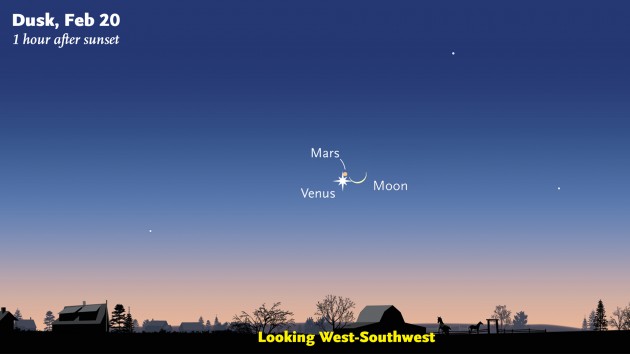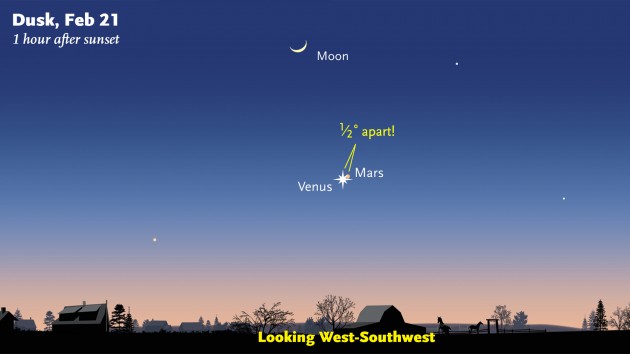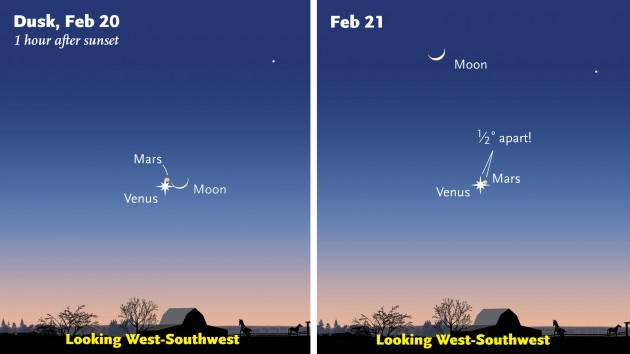Contacts:
Alan MacRobert, Senior Editor, Sky & Telescope
855-638-5388 x2151, [email protected]
Kelly Beatty, Senior Editor, Sky & Telescope
855-638-5388 x2168, [email protected]
| Note to Editors/Producers: This release is accompanied by publication-quality illustrations; see details below. |
Look west in twilight this Friday and Saturday (February 20th and 21st), and an unusual astronomical sight will await you.
Brilliant Venus and faint Mars will be paired remarkably close in the sky. And on Friday evening, the crescent Moon joins them in a tight bunch, a beautiful sight. On Saturday Venus and Mars appear even closer together, with the crescent Moon now looking down on them from above.
When it comes to "eyeball astronomy," nothing is more satisfying than to see a pair of celestial objects appear close together in the sky, what astronomers call a conjunction. And 2015, notes Sky & Telescope's longtime contributing editor Fred Schaaf, truly deserves to be called the "Year of the Conjunctions." In January we watched Venus and Mercury come together in the evening twilight, and now comes a similarly close pairing of Venus and Mars. On Saturday they'll appear 1/2° apart for viewers in North America. That's about the width of a pencil held at arm's length.
Venus and Mars have been edging closer together all month. Venus blazes in the southwest during late dusk; it's been climbing a little higher week by week. Mars, meanwhile, has lingered in roughly the same part of the twilight sky for several months, refusing to depart. Last week Mars was about 8° above Venus, but from February 17th through 26th, the two remain within 2° of each other. They're less than 1° apart (about your little finder's width at arm's length) from the 20th through the 23rd.
Mars is only about 1% as bright as Venus just now. Since the pairing on the 21st is so close, Schaaf cautions, "little Mars might be hard to see in Venus's glare without optical aid." In other words, grab binoculars or a telescope to enhance your viewing experience.
Both worlds will fit together in a medium-power telescopic view. Venus's dazzling white disk, shining at magnitude –3.9, is 12 arcseconds wide and gibbous in shape (88% illuminated), whereas peach-colored Mars is much dimmer, magnitude +1.2 or +1.3, and a tiny little shimmering blob just 4 arcseconds across.
And with the crescent Moon in the same scene? Get those cameras ready!
Differing Distances
Although these objects appear close together as you watch them in the deepening dusk, they're really not. Venus is 134 million miles from Earth right now, while Mars is 203 million miles away. The Moon is much, much closer: only about 225,000 miles distant. You may have driven that many miles in your lifetime.
The dance continues through the end of February, when Mars is still within 4° of Venus. By then the order will have switched, with Mars lower down.
Sky & Telescope is making publication-quality illustrations available to our colleagues in the news media. Permission is granted for one-time, nonexclusive use in print and broadcast media, as long as appropriate credit (as noted in the caption) is included. Web publication must include a link to www.SkyandTelescope.com.

Sky & Telescope diagram

Sky & Telescope diagram

Sky & Telescope diagram
For skywatching information and astronomy news, visit SkyandTelescope.com or pick up Sky & Telescope, the essential guide to astronomy with subscribers in more than 100 nations. Sky & Telescope and SkyandTelescope.com are divisions of F+W, a content + ecommerce company. F+W also publishes two annuals (SkyWatch and Beautiful Universe) as well as books, star atlases, posters, prints, globes, apps, and other fine astronomy products.
 0
0